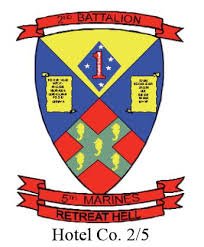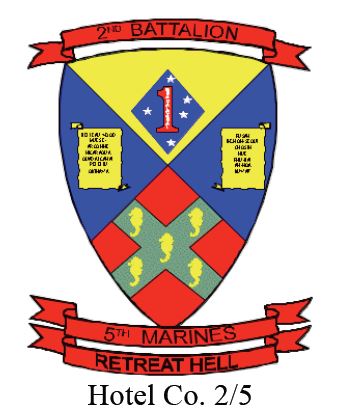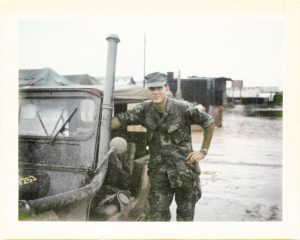 I was issued a brand new M151A1 jeep when I was issued my driver’s license on August 29th on Hill 65. There
I was issued a brand new M151A1 jeep when I was issued my driver’s license on August 29th on Hill 65. There 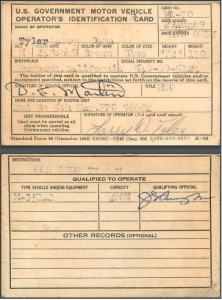 was no driver’s test. I was asked one question, “Have I ever driven a tractor?” I replied “yes”. Lt Martin handed me my ID card after I signed it and he pointed to the jeep. I jumped in it. Turned it on, gave it some gas, popped the clutch, and drove away on top of Hill 65. Wow! I had my very own brand new jeep! I drove it around the hill for about 30 minutes before I realized that it needed some fuel. I had to go back to the motor pool and fill up the tank.
was no driver’s test. I was asked one question, “Have I ever driven a tractor?” I replied “yes”. Lt Martin handed me my ID card after I signed it and he pointed to the jeep. I jumped in it. Turned it on, gave it some gas, popped the clutch, and drove away on top of Hill 65. Wow! I had my very own brand new jeep! I drove it around the hill for about 30 minutes before I realized that it needed some fuel. I had to go back to the motor pool and fill up the tank.
Larry’s brand new jeep (see picture to the left) after getting back from a daytime drive to a nearby Vietnamese village near Hill 65 in September 1969. There are mostly dirt roads. I spent a lot of time cleaning this jeep over the three months I drove it for Sgt Major Burks, Sgt Major Williams, and the battalion commander Lt. Col. Bowen. I think this was the only time my jeep was very dirty after taking the CO to Liberty bridge and back on a rainy day.
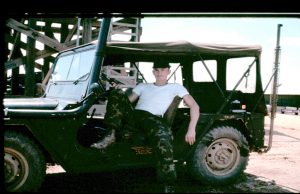 I took this picture of one of my Hill 65 buddies posing in the Colonel’s jeep who was a radio operator for the CP, S2 I think. I kept the jeep very clean except for the tires that got dirty every day.
I took this picture of one of my Hill 65 buddies posing in the Colonel’s jeep who was a radio operator for the CP, S2 I think. I kept the jeep very clean except for the tires that got dirty every day.
Notice the deep-water fording kit! Both the air intake tube and the exhaust extension tail pipe extend 60 inches above the ground.
While fording a river, I could travel at about 4 MPH and was very careful to prevent an engine stall. I used the clutch as little as needed while in the water and dried out the brakes by allowing them to drain away the water before relying on them. Driving in the water is very different than driving on land. Each time I went out knowing I had to ford a river (not very often), I would go through a check list of things to inspect before and after operation of the vehicle to protect it from being damaged.
 Sargent Major Clifford Burks, (the one on the left in the picture) thought that the brand-new jeep that was just assigned to me on August 29, 1969, at Hill 65 needed to be broken in. I just picked up the vehicle a few days earlier. It was provided to me to drive him and the Commanding Officer, Lt Col James Bowen around in for the four months we were at Hill 65. The Sgt Major scheduled some “Twilight Raids” with himself, an available machine gunner, and me to go out on night raids after dark with the new jeep.
Sargent Major Clifford Burks, (the one on the left in the picture) thought that the brand-new jeep that was just assigned to me on August 29, 1969, at Hill 65 needed to be broken in. I just picked up the vehicle a few days earlier. It was provided to me to drive him and the Commanding Officer, Lt Col James Bowen around in for the four months we were at Hill 65. The Sgt Major scheduled some “Twilight Raids” with himself, an available machine gunner, and me to go out on night raids after dark with the new jeep.
Because the mountain range (Charlie Ridge) to the west of Hill 65 was very tall, it would get dark quickly once the sun set over the mountains. Twilight lasted about 25 minutes in this part of the world, then it would get very dark unless there was a full moon which usually came out later in the evening.
The Sgt Major liked going out on one hour “Twilight Raids”. It was his idea. We did so while stationed on Hill 65 about six times. He rotated back to the States at the end of September, four weeks after he started these raids, so our evening jeep raids ended. I was very thankful for that.
So, what is a “Twilight Raid” anyway? I was commanded by the Sgt. Major to take him and a machine gunner, drive off the secure base at Hill 65 without any lights on, and drive sometimes east or sometimes west of the secured base for 30 to 40 minutes in either direction as it began to get dark. No one was allowed on the dirt road after dark. Curfew was at dark for everyone. We had no specific place to go. His idea was to have the enemy spot us moving on the road after dark allowing them to shoot at us. That then gave us an opportunity to determine where the fire was coming from and then we’d shoot back with our M16s and the M60 machine gun. I felt like a part of a commando squad driving outward in the blackness of the night trying to get Charlie or the NVA to shoot at us, just so we could fire back at them.
Fortunately for me, I was a radio operator, so I always notified everyone on Hill 65 with my call sign to pass the word to every Marine not to shoot at us while we were out on the Route 4 road after dusk. I would radio the battalion command post when we left the hill and again when we were arriving back. On the way up the hill, I always flashed my lights on twice to let them know it was us and not the enemy coming in. Unfortunately, I didn’t have access, nor the authority to inform the Koreans nor the ARVNS that we were friendlies driving around out there in the dark of the night with no lights on.
With the backseat removed, the machine gun was mounted and strapped into the back of the jeep so it could fire to the passenger’s right side and to the back behind the jeep. We would place sandbags around the tripod and around the cans of M60 ammo belts. We did not have a mounted swivel pole for the M60 to mount on. The gunner knew not to shoot at my extended exhaust tailpipe mounted on the driver’s rear corner of the jeep. I had the jeep canvas cover removed, and the windshield latched down flat over the front hood of the engine. We wore our seatbelts, flak jackets, helmets, and goggles. I would lay my M16 across my waist pointing it to the left side of the jeep. The Sgt. Major would be in the passenger seat with his M16 laying across his lap pointing it out to the right side of the jeep. The googles worked great for my two passengers keeping the bugs and the flying dust and mud from getting into their eyes. I usually wore my goggles around my neck so I could see where to drive and miss the larger potholes in the muddy dirt road. With the mud or heavy dust flying, the goggles were useless for me to see where I was driving in the dark. I was trying to stay on the dirt road and not hit anything in the road.
Our twilight raid cruises would last about an hour or so long. With exception to one of the nights, we always forged the Song Vu Gia River where the road crossed it. The water would be at least waste deep and once chest deep. I’d put my M16 over my helmet and across the top of my shoulders behind my head so I could continue to drive with two hands while fording in the water. The Sgt Major would always hold his and my pistols above the water level. The machine gunner would also hold his pistol above the water along with the radio handset so it wouldn’t get wet. Sometimes the M60 got wet depending on how high the river was when we crossed it. The machine gunner was thankful that the ammo boxes were waterproof.
Yes, we had to turn around and go back the same way we had come so we always crossed that river twice on each raid. I’m sure I said a short prayer every time I either stepped on the gas pedal or stepped on the brakes while driving on these raids. The river water always felt cold after sunset when we were driving through it. This was the craziest thing I ever did in Vietnam.
During those six twilight raids, we were sniped at twice and on the last time we were out there in the dark, after we crossed back across the river the second time, we drew lots of fire. I drove like a maniac weaving to the left and to the right as I was driving really fast. The Sgt Major was firing his M16, and the machine gunner opened up shooting at everything in the dark terrain around us. Being in radio contact with the base, they knew we had taken on fire. They immediately sent out from Hill 65, an M48 Patton tank that greeted us on the road about a half mile from the base. The tank followed behind me as I drove back to Hill 65. We will never know if we ever hit any enemy.
I found out a month after we started the night raids and did the water fording through the river that the Sgt Major wasn’t so crazy after all. Sgt Major Burks had made a deal with someone at 1st Marine Division to get one of those brand new M151A1 jeeps with the new deep water fording kits. They arrived in country only a short time before I got this one. He had to “test it out several times” and make a report back to 1st Mar Div Transportation Chief on how successful the deep water kit was or if the system failed while being tested. I had no idea I was the one testing the new kit out. I’m so glad that it did work and I never stalled or drowned out the engine even when we were in deep water with a current flowing.
Whenever the Sgt Major or the CO was traveling somewhere, it was my job to be with them and keep them safe. While on Hill 65, when these two men were busy performing their daily duties in the command bunker, I had lots of free time available so I was able to perform lots of services to help out our men in the field and on the Hill. First, I volunteered to drive anyone around on the Hill. I was like their private Uber driver. Hill 65 was almost ½ mile long from the very north end to the south end of the hill. I’d give guys lifts to the mess hall, officers to the LZ, etc. I’d drive the mail sacks to the LZ daily. I’d drive the Sgt Major and the CO from the command bunker to the mess hall on occasions.
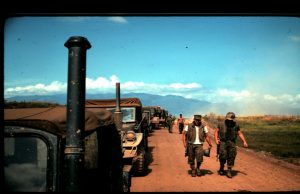 I can recall going on three drives with the CO to Da Nang, each time driving in a convoy for safety reasons. One trip was from Hill 65 to Da Nang, another from Hill 65 to An Hoa, another from An Hoa to Da Nang, twice. Each time driving in a convoy. Although those trips were less than 20 miles one way, it would take many hours traveling at very slow speeds due to the mine sweeps and occasionally having contact with the enemy. Some of the convoys would have up to 20 to 40 vehicles in them. There would be Marines walking on the flanks of the dirt road, tanks and armored vehicles stationed on the front and the back of each convoy.
I can recall going on three drives with the CO to Da Nang, each time driving in a convoy for safety reasons. One trip was from Hill 65 to Da Nang, another from Hill 65 to An Hoa, another from An Hoa to Da Nang, twice. Each time driving in a convoy. Although those trips were less than 20 miles one way, it would take many hours traveling at very slow speeds due to the mine sweeps and occasionally having contact with the enemy. Some of the convoys would have up to 20 to 40 vehicles in them. There would be Marines walking on the flanks of the dirt road, tanks and armored vehicles stationed on the front and the back of each convoy.
The convoys would be lined with 10 wheeler troop transport trucks, cargo trucks, armored personnel carriers, jeeps, trucks towing water, utility trailers, or armor. The road was dusty and dirty. Each of us driving or riding in a convoy ate dirt for the entire duration of the convoy. Once we were within the Da Nang safe zone, or the An Hoa compound gate, we no longer had to drive in a convoy.
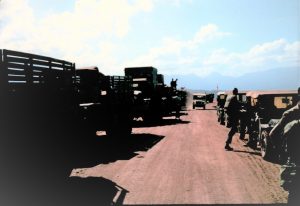 The enemy was always looking for any opportunity to stop our convoy so we couldn’t get supplies or personnel between Da Nang and An Hoa. They would plant bombs and other explosive devices in the roadway, snip at us with their rifles, and fire off rockets in an attempt to destroy a vehicle in the convoy.
The enemy was always looking for any opportunity to stop our convoy so we couldn’t get supplies or personnel between Da Nang and An Hoa. They would plant bombs and other explosive devices in the roadway, snip at us with their rifles, and fire off rockets in an attempt to destroy a vehicle in the convoy.
Driving my jeep in the 1st Marine Division Da Nang area was different than driving elsewhere. I had to obey stop signs, MP’s, guards, patrol officers, and stop at all checkpoints. Always after dropping off my CO and the SgtMaj, I’d go and get my jeep cleaned to get all the dirt, dust, and mud off of it. I even did so when it was raining out.
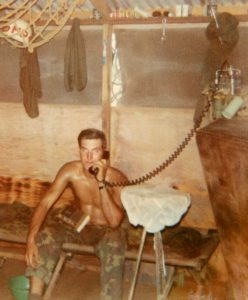 The Sgt Major made sure I had and wore an MP (Military Police) helmet each time I drove into Da Nang. With the helmet on, we didn’t have to completely stop, nor state our business at any of the checkpoints. The CO would smile, return a salute and I’d keep right on driving. On some occasions, the Sgt Major would high-five the Colonel after we passed by a checkpoint. Notice the MP helmet in the rope carrier above my head in the picture to the left.
The Sgt Major made sure I had and wore an MP (Military Police) helmet each time I drove into Da Nang. With the helmet on, we didn’t have to completely stop, nor state our business at any of the checkpoints. The CO would smile, return a salute and I’d keep right on driving. On some occasions, the Sgt Major would high-five the Colonel after we passed by a checkpoint. Notice the MP helmet in the rope carrier above my head in the picture to the left.
Each time I left the Da Nang area, I’d tuck the MP helmet back into a cloth bag I carried in my jeep. It sure came in handy. I always wondered what laws I broke wearing it and impersonating an MP? I was ordered by the SgtMaj to wear it and to keep on driving through all checkpoints. So, that’s what I did, and no one ever stopped me or questioned me.
At the middle of May 1969, I was a combat radio operator walking point out in the Arizona Territory. I had experienced combat almost daily for the past five months. A week later I was medivaced out of a firefight with a heat stroke. Ten weeks later I was the battalion commanding officer’s jeep driver, his personal aid, and radioman. I did not take that lightly. I was chosen out of a lot of other more qualified men to serve these two men. I knew God was watching over me. I took my new job very seriously. I decided that I needed to remain humble and serve these men and all my fellow Marines as best as I could. I hand washed that brand new jeep at least twice every day while staying on Hill 65. I always wanted it to look nice for the Lt Col.
Having a new jeep and keeping it very clean at all times paid off. When we were in An Hoa for a change of command ceremony, I was selected to drive around a one star general! That was cool.
In early October 1969 on a Thursday, SgtMaj Williams scheduled for himself and I to go to Da Nang on a supply run. I drove the CO and his jeep. We took along another Marine radio operator who was not scheduled for duty that day. While the Sgt Major did the shopping, we loaded the carts with the supplies. For the first time in the Marine Corps, I got to see and have access to a military PX. The Sgt Major bought cases of paper, pencils, pencil sharpeners, ink pens, erasers, paper clips, rulers, liquor, beer, cases of candy bars, cases of potato chips and boxes and boxes of ice cream bars. He bought dry ice to wrap around the tons of ice cream bars that we bought. I learned on this “supply run” that it was Lt Col Bowen who liked ice cream! We backed the jeep as high as we could with all these supplies and headed back to catch the late afternoon truck convoy back to Hill 65.
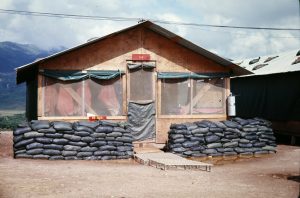 After we got back, to my surprise, all the goodies the Sgt Major bought were placed in my hutch (I had my private quarters in the mailroom on Hill 65). I was to stand guard over all of it overnight. Except for a couple of ice cream bars that the CO, Sgt Major, and I took and ate, the rest of the goodies remained safe overnight. The next day was a Friday. I knew about the “open air” school that a Vietnamese village at the bottom of Hill 65 where children were being taught. The front of the schoolroom (outside) faced our hillside. The back of the schoolroom faced the Song Vu Gia River. The schoolroom had a 10-foot ceiling covered with bamboo and palm branches. All sides of the classroom were open, no walls. There were about 75 kids sitting on mats with small chalkboards in their hands.
After we got back, to my surprise, all the goodies the Sgt Major bought were placed in my hutch (I had my private quarters in the mailroom on Hill 65). I was to stand guard over all of it overnight. Except for a couple of ice cream bars that the CO, Sgt Major, and I took and ate, the rest of the goodies remained safe overnight. The next day was a Friday. I knew about the “open air” school that a Vietnamese village at the bottom of Hill 65 where children were being taught. The front of the schoolroom (outside) faced our hillside. The back of the schoolroom faced the Song Vu Gia River. The schoolroom had a 10-foot ceiling covered with bamboo and palm branches. All sides of the classroom were open, no walls. There were about 75 kids sitting on mats with small chalkboards in their hands.
On this Friday morning, the Sgt Major had me load up the jeep with the all of the previous day‘s supplies with exception to the liquor and four cases of ice cream bars which stayed wrapped in dry ice and placed under my cot. He told me that all the supplies were purchased with his and the CO’s personal money, not the Marine Corps, to give out at the school at the bottom of Hill 65.
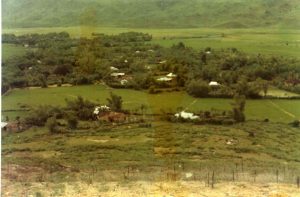 Lt Col Bowen and Sgt Major Williams and I jumped into that loaded jeep and drove off the Hill to the location of the school. At first, I was a bit afraid because I was the only one with an M-16 in case we ran into some unfriendlies. Each of us packed our .45 pistols. I also carried my radio installed in the jeep. To my surprise, when we arrived at the school, there was a full platoon of Marines from Echo company flanked out around the whole schoolyard participating our arrival. So, I secured my M-16 in the jeep after removing the round in the chamber and removing the magazine. I carried a special lock for that purpose. While the Sgt Major and the CO were hob knobbing with the three civilian adults and the four young female teachers, I was passing out the ice cream bars. I was surrounded very quickly with a lot of kids. I only wished I knew some Vietnamese words to communicate with them. Big smiles went a lot way though.
Lt Col Bowen and Sgt Major Williams and I jumped into that loaded jeep and drove off the Hill to the location of the school. At first, I was a bit afraid because I was the only one with an M-16 in case we ran into some unfriendlies. Each of us packed our .45 pistols. I also carried my radio installed in the jeep. To my surprise, when we arrived at the school, there was a full platoon of Marines from Echo company flanked out around the whole schoolyard participating our arrival. So, I secured my M-16 in the jeep after removing the round in the chamber and removing the magazine. I carried a special lock for that purpose. While the Sgt Major and the CO were hob knobbing with the three civilian adults and the four young female teachers, I was passing out the ice cream bars. I was surrounded very quickly with a lot of kids. I only wished I knew some Vietnamese words to communicate with them. Big smiles went a lot way though.
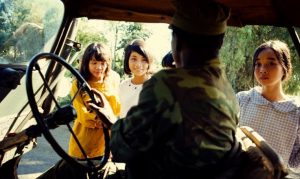 All the school supplies and all of the candy bars were presented to the four teachers. I packed up the empty ice cream boxes and dry ice and placed them back into the jeep. On the way back up the hill, the CO asked me if I had any leftover ice cream bars. I thought he meant brought back with with me on the jeep. I told him “no”. He then told me he was going to court martial me for not saving him any ice cream bars! The Sgt Major quickly let him know that I had stashed away a few cases of ice cream bars in my hutch and that he wasn’t going to get any of those ice cream bars if he pursues the court martial! I brought the CO an ice cream bar each day if we weren’t out in the field until they ran out two months later. The Sgt Major didn’t really like ice cream. His favorite thing was root beer. I ate both the ice cream and drank the root beer. After all, I was their food taster!
All the school supplies and all of the candy bars were presented to the four teachers. I packed up the empty ice cream boxes and dry ice and placed them back into the jeep. On the way back up the hill, the CO asked me if I had any leftover ice cream bars. I thought he meant brought back with with me on the jeep. I told him “no”. He then told me he was going to court martial me for not saving him any ice cream bars! The Sgt Major quickly let him know that I had stashed away a few cases of ice cream bars in my hutch and that he wasn’t going to get any of those ice cream bars if he pursues the court martial! I brought the CO an ice cream bar each day if we weren’t out in the field until they ran out two months later. The Sgt Major didn’t really like ice cream. His favorite thing was root beer. I ate both the ice cream and drank the root beer. After all, I was their food taster!
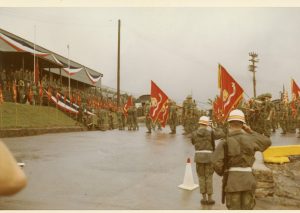 Later in mid-December 1969, there was a change of command for the 1st Marine Division that my commanding officer had to attend. While I was parked in the 1st Mar Div parking lot and remaining in the jeep alone, a Colonel spotted my jeep and asked me who’s jeep this was. After I told him it belonged to Lt Col Bowen, that same Colonel standing next to me ordered me to drive up to the CP entrance. He jumped into my jeep and pointed. The only thing he told me was that I would be the third jeep in the lineup. I did as he asked and pulled out of the parking lot and into the driveway in front of the 1st Mar Div office building and pulled up behind the first two jeeps that were already parked there with the driver idling waiting for marine personnel. The Colonel jumped out of my jeep and entered the building.
Later in mid-December 1969, there was a change of command for the 1st Marine Division that my commanding officer had to attend. While I was parked in the 1st Mar Div parking lot and remaining in the jeep alone, a Colonel spotted my jeep and asked me who’s jeep this was. After I told him it belonged to Lt Col Bowen, that same Colonel standing next to me ordered me to drive up to the CP entrance. He jumped into my jeep and pointed. The only thing he told me was that I would be the third jeep in the lineup. I did as he asked and pulled out of the parking lot and into the driveway in front of the 1st Mar Div office building and pulled up behind the first two jeeps that were already parked there with the driver idling waiting for marine personnel. The Colonel jumped out of my jeep and entered the building.
After stopping my vehicle, I noticed that I was exactly in front of the entrance way of the building. I thought how cool that was that my CO wouldn’t have to walk very far to find his jeep. There my CO, Lt Col James Bowen greeted me and oddly climbed into the back seat of my/his jeep. That had never happened before. What the heck was going on, I wondered? Then he ordered me out of the jeep with the engine running and to stand at attention. So, I did. Then, to my surprise, MajGen Ormond R. Simpson. (a two-star general who was in charge of the 1st Marine Division) stepped out from the doorway and was escorted over to my jeep. He climbed into the front seat of my jeep! I immediately saluted him as well as my CO. The General saluted back. I climbed back into the driver’s seat and he spoke to me and shook my hand. Wow, I got really nervous and lost it for a moment. I had no idea what I was supposed to do. I never learned in boot camp about how to address a general of the Marine Corps. Was I supposed to start the engine? Oh ya, it was already running! Was I supposed to put the jeep into gear? Was I supposed to only look straight ahead and not look at him? I swallowed hard. I sat up straighter in my seat. I waited until the jeep in front of me began to move. I then followed that second jeep. There were six of us jeeps in line traveling together over to the parade grounds. Reality then set in; I was driving not just any general but General Simpson from his CP to the parade deck where the change of command ceremony was to take place.
 I had no idea of what protocol was escorting a General in my jeep. Later that evening, My CO thanked me for my good performance and for always keeping his jeep so pristine clean! He told me that our jeep was selected because it was the cleanest and had no scratches or dents in the paint anywhere. Lt Col Bowen also told me that the General especially liked it when we arrived at the parade deck, that I immediately turned off the engine, jumped out and ran around to the General’s side of the jeep and saluted him before he got out of the jeep. Later I found out that protocol was that the jeep drivers were supposed to stay in their driver’s seat and wait to drive away after the passengers exited the vehicle so other vehicles could immediately unload.
I had no idea of what protocol was escorting a General in my jeep. Later that evening, My CO thanked me for my good performance and for always keeping his jeep so pristine clean! He told me that our jeep was selected because it was the cleanest and had no scratches or dents in the paint anywhere. Lt Col Bowen also told me that the General especially liked it when we arrived at the parade deck, that I immediately turned off the engine, jumped out and ran around to the General’s side of the jeep and saluted him before he got out of the jeep. Later I found out that protocol was that the jeep drivers were supposed to stay in their driver’s seat and wait to drive away after the passengers exited the vehicle so other vehicles could immediately unload.
 The red lines on the map show the roads that I drove on.
The red lines on the map show the roads that I drove on.
The road from An Hoa northeastward through the Phu Nhuan’s (small hamlets) to Phu Loc 6 at Liberty Bridge (known as Liberty Road) was all dirt.
The road from Liberty Bridge, Route 540 north to Route 4 was all dirt to Hill 65.
Route 4 from Hill 65 to Bien Ban to connect to Route 1 was all dirt.
At Bien Ban, Route 1 was a blacktopped road all the way north to Da Nang.
Picture below is Liberty Road from An Hoa headed to Phu Loc 6.

M151A1 Military Jeep.pdf
Larry D. Tyler
0311
